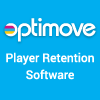What can be done when mass marketing fails? Rather than encouraging engagement and improving brand perception, generic marketing to large swatches of one’s target audience will often lead to brand fatigue and even negativity. In a session with Amit Bivas, Head of Marketing for Optimove, Amit discussed the solutions to this challenge. Amit stressed, “We cannot use the same marketing strategy we used the day before because today it is a whole different game.” To really get into how you can improve catered marketing, tune in below.
DOWNLOAD SLIDES

Amit Bivas is Optimove‘s Head of Marketing. They got their start in industrial and information system engineering, having learned much from Optimove founder and CEO Pini Yakuel, who was the professor at the school they were attending. After completing Pini’s course, Amit offered to join them at their company.
“I started as a marketing data analyst, consulting to customer-centric businesses on how to improve their customer marketing,” said Amit. “One year later, Pini offered me to lead Optimove’s marketing. Lead is quite a big word, as I was the first person actually doing marketing for the company. In the last four years I structured the department, which now consists of more than a dozen top-tier marketers who are helping to spread the word and portray us as the industry’s leading customer marketing cloud. Our marketing team is a very unique group of people - and they’re playing an essential part in growing Optimove and placing it at the forefront of its space.”
The experience Amit acquired with data analysis, statistics and marketing consulting has helped them understand the scientific half of marketing. Working with Optimove’s technology before working on marketing gave them a greater understanding of the company’s customers and prospects. and ways to find solutions to professional challenges.

“I’m a big fan of communication,” Amit noted. “Marketing is all about communicating with different audiences and providing them with “a-ha!” moments. As an individual, this was always something that fascinated me – how to enthuse people by telling them the “right” story.”
Telling a Story with Marketing
Amit puts a lot of pride into the team that they work with. They said that their proudest moment was when they saw their team functions independently of them for the first time. Amit’s greatest pleasure in their job is the friendships they’ve made with the group of experts they work with.
“I also love the content of my job: the retention marketing space is always changing and evolving, raising new marketing challenges that require one to constantly think out of the box,” detailed Amit. “And I greatly enjoy the fact that marketing in this era requires me to use a dual skill set of art and science, which are two disciplines that I appreciate very much. There’s never a dull moment, and there are always new frontiers.”
Rendering services is Amit’s passion, whether it’s indirectly via communications or directly via having a stall in a market, they’d be doing something similar to what they are now even if they weren’t at Optimove. They see marketing as a sort of storytelling and they see something inherently interesting.
“At the end of the day, storytelling lies at the heart of marketing,” Amit posited. “Consumers don’t buy into your product or your offer, they buy into the story you’re telling them about your product and about how it figures into their own story. Storytelling is one of the most ancient human arts, and the need for it today is as pressing as it was for cavemen 20 thousand years ago.”

Targeting, Personalizing, and Communicating
When communicating about a product, the most common mistake that Amit sees is sending the same content to large groups of customers. They note that consumers will just block this out in 2016, noting there’s no excuse for “spray and pray” advertising. Instead, Amit suggests that marketers look to personalize their ad approach.
“The first step is segmenting players based on their lifecycle stages: one cannot address a new player as he would address an active player, or a player that’s churned,” detailed Amit. “The next step is breaking down lifecycle stages based on behavioral attributes – recency, longevity, monetary values, game and platform preferences and many more. It’s important to note that players change over time, and so should player segmentation. This process must be dynamic, and recalculated frequently. New age players have a crazy-high pitch, and marketers need to keep up. If you don’t update segments frequently, players are bound to leave for the competition.”
“Once you’ve established homogenous groups, you need to start building content that’s relevant to them, and send out campaigns as marketing experiments,” they continued. “Even the best marketer’s intuition needs to be tested and validated against a control group. When the results are in, keep trying to outperform them and get better results per each target group.”
Taking a multi-channel to marketing is a key to catching a target audience’s attention. The way to do that is go where the players are and market to them in the mediums that they use. “This changes from one player to the next, so you need to have a testing mechanism in place in order to understand which player persona is responsive to which channel or combination of channels,” said Amit. “If they’re likely to respond to a push notification, don’t send them an email. If a certain player persona doesn’t respond to emails, send them a text message informing them that you have a crazy promotion waiting for them in their inbox—that’ll push them to open your email. If you get multi-channel marketing right, players’ responsiveness to your communications will grow in orders of magnitude.”
Understand > Interact/Engage > Monetize
For customer marketing, Amit sees the issue as being one of “personalize or vaporize”. That catchy term is meant to convey that if companies don’t communicate to customers in a personalized way that appeals to their customers, they’ll end up vanishing. Consumers are more savvy than ever about what to buy and information that’s available to them, and game publishers need to appeal to their customers with an understanding of what they like, want, and need.
“In order to incorporate this trend into our product, we develop Optimove to help more brands achieve exactly that level of communication. Currently this might be considered a luxury, available only to publishers on the cutting edge of technology, but in the future it will be a necessity – the be all and end all of any customer facing enterprise.”
Amit evangelizes the approach of “Understand > Interact/Engage > Monetize” when helping publishers monetize. They see it as key to not start with monetization – it’s key to understand who players are and what they like. Only after a user has been engaged and a publisher gains their trust can one monetize. It’s not a good strategy to try and get as much money as one can in a short period of time – it’s more important to try and get them to stay and not burn them out.
It’s another issue to make sure that marketers don’t make their product part of the noise, flooding customers with ads and causing “banner blindness” for an ad. It goes back to the issues of serving players the right information in the right place with the right tone. “This requires personalization of marketing campaigns at scale, and the ability to contextualize communications to each individual player’s affinities,” says Amit. “Using cutting edge technology such as predictive analytics, machine learning and cluster analysis enables marketers to deeply parse player data and engage each player in an emotionally intelligent manner that is sure to turn that ‘noise’ into exciting music.”
Specifically for games, Amit notes that players that pay feel they’re have a valuable experience, but that isn’t always the same as a good experience. “If you want to create loyal, satisfied customers, you have to learn their needs and deliver on them through contextualized, emotionally intelligent communications,” they note.
Using the Right Data and Tools to Succeed
To Amit, top level marketing calls upon both subjective evaluations and intuition which then should be validated with data. They describe it as a meld between art and science making the best sort of marketer a cross between “Don Draper and a master hacker.” Agility is needed in a space which is constantly changing and evolving.
“The biggest challenge is the competition and the fact that the customer marketing space is changing very quickly and becoming ever more crowded,” Amit notes. “To stay at the top of our game we need to remain agile and hone our ability to react very quickly to an ever-changing environment. Staying ahead of the curve and maintaining our position as leaders in our space is an on-going effort.”
It’s a lot of work to get marketing right, but Amit is confident his company provides the tools publishers need to succeed. “Robust technologies such as Optimove, which are fueled by player data, require a complex onboarding process,” Amit detailed. “This is justified by the added value you can get from such a solution. Since Optimove is deeply integrated with publishers’ databases and data warehouses, the levels of personalized communications it can reach are mind-blowing. We’re not talking about Dear *|fname|*, geo-targeting, lookalike, etc. We’re talking about predictive, real-time, behavior-based communications that enable emotionally-intelligent customer marketing at scale.”

“This is indeed quite an undertaking, but our onboarding and integration teams are true professionals in building bespoke customer models, and the value our clients get out of these personalized models greatly outweigh the complex onboarding,” they concluded.
Comments











